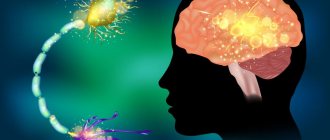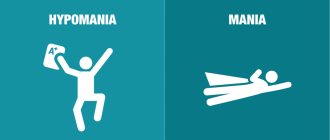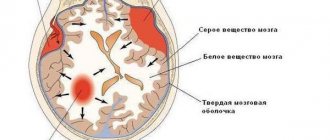Kinds
- True. The patient sees, feels or hears something, but this phenomenon is bright, living in nature. The hallucination is real for the sufferer.
- Pseudohallucinations. These are visions, sounds or sensations that occur outside of objective reality.
Important: false hallucinations usually depend on suggestion or the influence of external factors.
Hallucinations vary depending on the specific sense organs that perceive:
- Visual. These can be entire storylines, mystical visions, just flashes of light or smoke. And also animals, identical objects, vision of organs in one’s body or foreign objects, etc.
- Auditory. These include ordinary noises or sounds, as well as verbal ones: imperative, when a certain voice orders the patient to do something, usually it is negative; commenting - voices discuss the patient’s thoughts, feelings and sensations, they are also negative and judgmental; contrasting, when the patient hears 2 voices directed against each other, one condemns the patient, the other defends, but at the same time they give conflicting commands to the sufferer; speech motor - it seems to the patient that certain forces are speaking for him, in an unknown language.
- Olfactory. The patient complains of unpleasant odors.
- Flavoring. The patient may experience unpleasant tastes in the mouth.
- Tactile: sensation of liquid, different temperatures, insects crawling, hugging.
- Functional. Against the background of any objects or phenomena, imaginary images, sounds, etc. appear.
- Hallucinations of Bonnet. The imaginary sensation is perceived by the analyzer that has completely or partially lost its function.
- Hemianoptic. Occurs due to a disease called hemianopsia. This is when the patient sees only half of the field of vision. Imaginary sensations arise in the area that does not see.
- Hypnagogic and hypnopompic hallucinations. They can occur even in a healthy person. They appear in the form of imaginary images or sounds that accompany a person when waking up or falling asleep. They are connected with the events of the day experienced.
Types of hallucinations depending on the analyzer:
- Psychomotor, when the patient feels that part of his body is in motion.
- Reflex, when, with a real impact on one analyzer, another is excited.
- Ecstatic. Vivid pictures or entire images appear in a state of altered consciousness.
Important: hallucinations must be distinguished from mirages and illusions, because they arise based on other factors.
Symptoms and signs of hallucinations
To explain it in simple terms, hallucinations arise as a result of a malfunction of any system responsible for the perception of the surrounding world. So the patient may seem to have some visual objects or his auditory perception may be distorted. A psychiatrist diagnoses hallucinations.
Most often, at the initial stage, such hallucinations occur with the eyes closed, when a person goes to sleep. This is preceded by frequent abuse of alcohol or drugs.
Hallucinations can be true or false. The difference is this: true hallucinations - a person is confident in their reality, and does not question the fact that they do not exist in reality, and this is the result of a failure in his perception system. The patient sees such phenomena in the world around him.
False hallucinations arise in a person’s head. For example, a patient hears voices in his head; he may believe that someone is communicating with him mentally and influencing his condition and decisions. Such conditions accompany schizophrenia.
Causes
Misleading images, sounds, or sensations may occur when:
- Dementia. It seems to the patient that objects are moving.
- Parkinson's disease. Visual images appear: people, animals, objects, or even entire situations.
- Migraine. Patients see flickering or colored zigzag lines in the central region of the visual field. They leave behind a white spot that disappears after half an hour.
- Epilepsy. Visual images, in the form of bright spots or outlines.
- Sleep disturbance. Usually occur when waking up or falling asleep.
- Brain stem infarction. Bright and colorful scenes appear. They usually carry a semantic load. They can last from 1 minute to several hours.
- A brain tumor. Hallucinations can be of different types. This depends on the localization of the pathological process.
- Creutzfeldt-Jakob disease. It occurs due to prion infection and causes dystrophic processes in the cerebral and spinal cord, basal ganglia. Visual hallucinations occur: color changes, perception in reduced sizes, distortion of object characteristics, etc.
- Sclerosis of cerebral vessels. Auditory and visual hallucinations appear.
- Stroke.
In addition to the reasons described above, the culprits of hallucinations may be: Aging.
- Infectious diseases.
- Pathologies of internal organs.
- Intoxication with medications.
- Poisoning with toxic substances.
general information
Olfactory hallucinations (phantosmia) are a condition in which a person perceives non-existent odors, which can be both pleasant and disgusting. As a rule, there is a tendency to feel unpleasant odors: burning, rotten fish, etc. Phantosmia may be constantly present or appear periodically and then disappear.
Along with olfactory hallucinations, there are parosmia - conditions in which the patient perceives a distorted odor from a real object. For example, some patients after Covid complain of smells of “rot” or “carrion” from quality products. The patients’ relatives do not feel anything like that, but “hear” the aroma that should normally come from the dish.
Which doctor should I contact?
Hallucination is not a separate disease, but a symptom that occurs when a particular organ is damaged, in most cases the brain. But in order to identify the real cause of the pathology, you need to consult the following specialists:
- Psychiatrist.
- Neurologist.
- Oncologist.
- Expert in narcology.
- Infectious disease specialist.
Hallucinations are an important symptom that indicates that the patient has certain disturbances in awareness of the surrounding reality. Patients are often embarrassed or afraid to talk about the presence of hallucinations, because they think that only people with mental disorders experience hallucinatory experiences.
IMPORTANT! This is a false, persistent belief; different specialists need to work with hallucinations. The fact is that hallucinations can occur due to the presence of a neoplasm or infectious pathology.
Therefore, make an appointment with a specialist from our center - a psychiatrist, neurologist, oncologist, narcologist or infectious disease specialist to find the root of the problem and eliminate the symptom!
Sign up
Mirror neurons and their role in the manifestation of mass hallucinations
Professor of Psychiatry and Neuroscience Marco Iacoboni is one of the first researchers to study and describe mirror neurons. Although this sensational topic is still full of mysteries and blind spots, Iacoboni notes that mirror neurons “lie at the core of our navigation system. They connect us with each other mentally and spiritually” [11, p. 144]. In other words, scientists may have found the key to our empathy, imitation of other people’s behavior (and, therefore, learning) [12].
The activity of mirror neurons was consistent with the activity of the frontal, temporal and parietal regions of the brain - and some neurons were active not only during execution, but also during observation of the action. According to Iacoboni, disturbances in the functioning of mirror neurons correlate with the manifestation of autism spectrum disorders [11].
The mechanism of imitation, in particular, lies in the manifestation of collective hallucinations. Consequently, the main direction of work in this area should be considered the research and establishment of the exact functions of mirror neurons, their development in onto- and phylogenesis, and their role in human socialization. However, the discovery of mirror neurons is already called one of the most important in the last ten years and the most promising area of research.
So, mass hallucinations are a phenomenon of unconditional interest for researchers, as well as for lovers of mysticism. This is a phenomenon, the very basis of which will always be conformity, a certain attitude of perception, reduced criticality in relation to what is seen, and often an unstable emotional background. But the main thing is people’s willingness to believe, not only their own eyes, but also the eyes of another person, in order to be involved in something amazing. As psychologist D. Rockliffe wrote: “Where there is faith in miracles, there will always be evidence of their existence. […] Faith produces hallucinations, and hallucinations confirm belief” [6, p. 436].
Treatment methods
Treatment methods for pathology depend on the causes that caused it. There is no single scheme. For example, in case of poisoning with toxic substances, you need to stop their effect on the body. If there are neurological causes, it is necessary to begin appropriate therapy or stop the acute form of the disease.
Treatment is usually carried out with:
- Neuroleptics.
- Antidepressants.
- Means to improve blood circulation in the brain.
- Antiparkinsonian drugs.
Auditory hallucinations in children
Auditory hallucinations in children of preschool and primary school age are a very common phenomenon. At this age, they are often caused by fever, various infectious diseases and traumatic brain injuries. But they can also appear due to violence, serious psychological shock as a result of any events they have seen or experienced that are terrible for them. Poisoning with various poisons and toxic substances can also cause a similar phenomenon. In addition, such hallucinations sometimes indicate the presence of a mental illness. But sometimes similar illusions arise in healthy children due to severe fatigue.
Lifestyle during hallucinations
The patient’s further life depends on the reasons that caused the pathology. If there is a disease that cannot be treated, then you need to constantly maintain normal functioning with the help of medications. If hallucinations were caused by certain diseases, then after getting rid of them you need to engage in further prevention.
Important: you should also give up bad habits, lead a healthy lifestyle, and strengthen your immune system.
If hallucinations occur, you should consider going to the doctor. Especially if the pathology is protracted. The symptom may indicate deep brain damage. If you make a diagnosis in time and start treatment, you can get rid of intrusive images, sensations or sounds.
The influence of phantosmia
Tastes and aromas have a huge impact on a person’s state and mood. Constant “stench” or even anticipation of an attack significantly reduces the quality of life and can provoke an increase in anxiety and the development of depression. The senses of smell and taste are closely linked, so people refuse food and lose weight, which adversely affects other functions of the body.
There are real dangers too. Inability to recognize the real smell due to olfactory hallucinations after Covid can lead to eating expired products or not responding to a gas leak in a timely manner. In professions that require the identification of odors, for example, working as a cook, sommelier or perfumer, phantosmia can cause disability.
What do tactile hallucinations mean?
Imaginary tactile sensations occur in a number of neurological diseases - dementia with Lewy bodies, Parkinson's disease, Alzheimer's. Sometimes they can be observed with delirium tremens, or delirium tremens, as well as cocaine abuse.
Tactile hallucinations can also be observed in schizophrenia. Various studies show that from 13 to 27% of patients with this diagnosis encountered such hallucinations. However, in schizophrenia, tactile hallucinations are usually accompanied by others, for example, visual and olfactory. However, in most cases, such hallucinations are not a sign of schizophrenia, but of a somatic or neurological disease.
Therapeutic measures
Therapeutic measures depend on the diagnosis given to the patient. Possible reasons include:
- mental disorders (personality disorder, schizophrenia, bipolar disorder, post-traumatic syndrome, psychotic depression);
- physiology (central nervous system injuries, Parkinson's disease, epilepsy, brain tumor);
- some infectious pathologies (infections of the lungs, bladder, brain, and other internal organs);
- use of chemical substances in large doses (nicotine, ethyl alcohol, illegal drugs).
Once the root cause is determined, the doctor draws up a course of therapy. Most often, antipsychotic drugs or antipsychotics are used to combat non-existent images. They block a number of dopamine receptors in specific areas of the brain, which helps reduce hallucinations. But antipsychotics do not always cope with the task. About 30% of patients continue to hear, see or experience images.
There are many non-pharmacological intervention options. Their effectiveness remains in question, but doctors still cannot find a quality alternative. One type of non-pharmacological intervention is cognitive behavioral therapy. It includes regular visits to a psychotherapist, who changes the patient’s attitude towards the problem. The therapist tries to eradicate the unpleasant/painful experience and get the patient to come to terms with the voices or visions in their own head. It should be understood that a complete cure through CBT is impossible; only a reduction in symptoms can be achieved.
Don't try to get rid of hallucinations on your own. Be sure to consult a doctor, go to group classes with people with a similar diagnosis, regularly visit a psychotherapist and remember that only you can control your own body and mind.
General characteristics of the condition
A hallucination is a certain image that appears in the human mind without an external stimulus, but has the quality of a real object, event or person. In simple words, it is a smell/sound/image/tactile sensation that does not actually exist. Hallucinations can develop at all levels of the senses, but most often patients experience auditory images.
Most cases involve psychiatric illnesses and disorders, but this is not always the case. Sometimes our consciousness independently forms images due to lack of sleep, the use of hallucinogens or stimulant drugs. It has been experimentally proven that sensory deprivation can also cause hallucinations.
Sensory deprivation is a partial or complete cessation of external influence on the senses. The condition leads to a decrease in the flow of nerve impulses into the central nervous system. Occurs in a confined space - an empty dark room, on a submarine, in zero gravity.
Content:
- General characteristics of the condition
- Types of hallucinations
- Consequences of hallucinations
- Therapeutic measures
- What you need to know about hallucinogens?
In the 1960s, experiments were conducted in which people were locked in dark rooms without access to sound or other external stimuli, creating conditions for sensory deprivation. After some time, people began to hear voices, see non-existent images and feel impossible tactile contact. Thus, science has proven that hallucinations can occur not only in mentally ill people, but also in absolutely healthy people. Nowadays, such experiments are excluded for ethical reasons.
Over the past thirty years, scientists have been actively studying the mechanism of hallucinations through neuroimaging and various types of tomography. This makes it possible to observe the activation of a specific part of the brain to a non-existent stimulus. What does this give and what results are already known?
Mechanism of appearance
Scientists still do not know for certain the mechanism of development of hallucination. The scientific community makes guesses, goes through diagnostic methods and tries to find the advantages/disadvantages of a particular theory. Let us consider the mechanism of occurrence of auditory hallucination, since it is the most common and studied.
The information below is a theory that has both opponents and followers. Although the evidence is somewhat weak, it remains one of the most influential of the last 20 years.
As soon as the patient hears someone else's voice, Broca's area strengthens in the brain. It is located in the lower frontal part of the organ and is activated at the time of speech. By the moment of speech we mean not only explanation with the help of sounds, but also internal speech. This is the voice that voices all our thoughts and seems to be inside our consciousness. When a person asks the question “What is the weather outside?”, he generates inner speech and activates Broca’s area. Sometimes the brain does not perceive inner speech and attributes it to non-existent objects or people. This is called an auditory hallucination.
How do scientists explain auditory imagery? The process of thinking and inner speech takes a split second. Human consciousness continuously generates new words, thoughts, actions, which make up our life. Once the brain connects to the process of inner speech, Broca's area sends signals to the auditory cortex (Wernicke's area). It is this signal that notifies the body that the speech we perceive is generated by us.
If speech is generated by the person himself, the sensory cortex muffles neural activity. If speech is generated by the interlocutor, neural activity increases in order to qualitatively support the dialogue.
Bottom line: an “alien” sound can develop due to a malfunction of Broca’s area and incorrect decoding of signals by the auditory sensory cortex. In fact, the sound that seems “foreign” to the patient is inner speech generated by the consciousness. Hallucinations involving other senses occur in a similar way, activating different parts of the brain.
What to do if you or your loved ones have tactile hallucinations?
Any hallucinations usually occur unexpectedly and can be accompanied by a feeling of severe fear both in the patient himself and in the people around him. In this state, a person is able to decide on sudden, thoughtless or even dangerous actions, for example, jumping from a bridge into the water to put out a fire on the skin, or making deep cuts to get rid of subcutaneous worms.
Under no circumstances should you ignore hallucinations that arise. Their root may lie in serious health problems that require immediate diagnosis by a specialist and appropriate treatment.
Don't put off visiting a specialist! Call us






